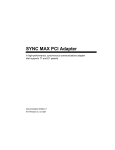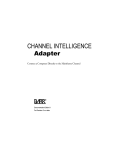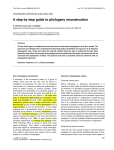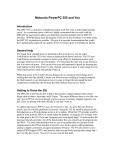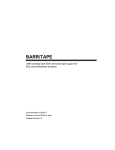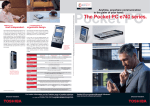Download CHANNEL-IN (ES) Manual
Transcript
CHANNEL-IN (ES) Use Fiber-Optic Technology to Connect a Computer Directly to the Mainframe Channel Documentation Edition 6 Adapter Revision 1 or later Editors Michele Nylander Jennifer Saam Katherine Sanchez Becky Senn Kathy Sutton Hardware Ken Clark Al Hodges Don Williams Copyright © 1998-2006 by Barr Systems, LLC All Rights Reserved. Barr Systems, LLC 4500 NW 27 Avenue Gainesville, FL 32606-7031 Phone: 800-BARR-SYS 800-227-7797 352-491-3100 Fax: 352-491-3141 E-mail: Web site: FTP site: [email protected] www.barrsystems.com ftp.barrsystems.com The Barr logo is a registered trademark of Barr Systems, LLC. ESCON and IBM are registered trademarks of International Business Machines Corp. All other trademarks are the sole property of their respective owners. July 1, 2006 ii Preface Preface Welcome to a high-performance product that directly connects your computer to an IBM mainframe. This manual tells you how to install the CHANNEL-IN (ES) hardware. Follow the instructions in this manual to install the CHANNEL-IN (ES) adapter. See your Barr software manual for software installation and hardware diagnostics instructions. Barr Technical Support You can contact Barr Systems by e-mail, fax, or phone to work directly with a Support Analyst. Our Frontline and Research support is available five days a week, Monday – Friday. Refer to the Technical Support Web site (www.barrcentral.com) for specific information regarding the hours of operation. Other methods of technical support include on-site visits, remote control service, and FTP server access. You have two easy-to-use support options available 24 hours a day, 7 days a week using the Internet. Knowledgebase – The knowledgebase system (www.barrcentral.com/support/kb) offers a complete database of solutions to known problems. Our knowledgebase is designed to locate solutions based on the symptoms you are experiencing. We search the same knowledge when you call or email us! When we solve your problem, we add it to our knowledgebase. Case Manager – If you’ve looked in our latest Help and knowledgebase and you still don’t find your answer, you probably need our Technical Support. We’ve opened our case tracking system up to you on Barr Central through Case Manager (www.barrcentral.com/support/cases). With Case Manager you can create a new case, add notes to the case, check its status, and attach diagnostics. Barr Systems is notified of these events so our Support team knows what you need and we keep in contact with you while the issue is being worked on. When you contact Technical Support, please include the hardware serial number and software version number in your correspondence. You can obtain the adapter serial number from any of the following places: Blue sticker on the adapter edge, visible from the rear of the computer Back of the adapter, where it is handwritten in permanent ink Blue sticker on the adapter box CHANNEL-IN (ES) iii Notes: iv Preface Contents Preface ......................................................................................................................iii 1. Introduction....................................................................................................... 1 1.1 Features ................................................................................................... 1 1.2 Computer requirements ........................................................................... 2 1.3 Package contents..................................................................................... 2 2. Install the Adapter............................................................................................. 5 2.1 Set the BIOS IRQ..................................................................................... 5 2.2 Insert the adapter in your computer ......................................................... 5 2.3 Test the adapter ....................................................................................... 6 2.4 Connect the fiber-optic cable to the adapter ............................................ 6 Federal Communications Commission Statement.................................................7 European Community Statement.............................................................................9 Glossary...................................................................................................................11 Index ........................................................................................................................13 CHANNEL-IN (ES) v Notes: vi Contents Introduction CHANNEL-IN (ES) hardware and Barr software allow you to connect the computer to a mainframe channel. CHANNEL-IN (ES) hardware includes the CHANNEL-IN (ES) adapter, coupler, fiber-optic cable, and the loopback plug. 1.1 Features The CHANNEL-IN (ES) hardware includes the following features. Direct connection to the mainframe channel CHANNEL-IN (ES) hardware provides your computer with a fast, direct link to the mainframe. The computer connects to the mainframe using the CHANNEL-IN (ES) adapter. Place the computer with the CHANNEL-IN (ES) adapter in a location that is convenient to the operator. A thin, flexible, fiber-optic cable connects the adapter to the mainframe. You can also connect the cable to an ESCON director, which is connected to the mainframe. With an ESCON director, you can attach multiple ESCON adapters to the mainframe. Convenient channel attachment When you connect a computer to the mainframe, you need the ability to isolate the mainframe from the computer environment. The Barr CHANNEL-IN (ES) adapter is a point-to-point fiber connection. You can disconnect the computer without affecting the mainframe or other channel devices because no other devices share the same piece of fiber. Fast access to the mainframe The CHANNEL-IN (ES) interface supports transfer rates up to 17 megabytes per second (MBps). For any type of computer-to-mainframe access, CHANNEL-IN (ES) provides a faster, more direct link that can dramatically improve your throughput and response times. CHANNEL-IN (ES) 1 Greater distance from the mainframe The CHANNEL-IN (ES) adapter includes an LED/multi-mode port. With a 62.5 micrometer fiber, you can reach as far as 3 kilometers without a channel extender. Distance improvement allows gateways to be located near file servers, instead of on the mainframe floor. Easy configuration The CHANNEL-IN (ES) adapter is a high-performance, PCI-compatible adapter. You do not need to set any adapter jumpers or switches with a PCI-compatible adapter. The CHANNEL-IN (ES) adapter fully supports interrupt sharing. 1.2 Computer requirements You can install CHANNEL-IN (ES) adapter on a computer that meets the following requirements. PCI 32–bit 5v, PCI 64-bit 3.3v, or PCI-X 64-bit 3.3v slots. The slot must be a full-height 3/4-length slot. 1.3 Package contents The CHANNEL-IN (ES) package contains the following items. CHANNEL-IN (ES) adapter 2 7-meter (23-foot) fiber-optic cable for connecting the adapter to the CHANNEL-IN (ES) device 1. Introduction Coupler for extending or testing the cable Loopback plug for testing the cable and adapter Protective cover for CHANNEL-IN (ES) adapter See your Barr software manual for software package contents. CHANNEL-IN (ES) 3 Notes: 4 1. Introduction Install the Adapter You can install the CHANNEL-IN (ES) adapter in an open, 32-bit PCI slot in your computer like any other PCI adapter. Follow these steps to install the adapter. 1. 2. 3. 4. Set the BIOS IRQ Insert the adapter in your computer Test the adapter Connect the fiber-optic cable to the adapter 2.1 Set the BIOS IRQ PCI technology means you do not have to set any adapter switches or jumpers, but it sometimes requires computer setup. Although your computer’s BIOS program can automatically set up PCI and ISA adapters, it might encounter IRQ conflicts with nonPCI adapters. (DMA and address conflicts are unlikely with PCI adapters because PCI adapters typically do not use a DMA setting, and their address range differs from nonPCI adapters.) To prevent conflicts, you need to tell BIOS which IRQ settings your non-PCI adapters use. You also need to make sure that at least one IRQ is available for PCI adapters. Before you install the CHANNEL-IN (ES) adapter, use your computer setup utility to check the BIOS IRQ settings. See your computer user’s manual for instructions. The device drivers that accompany some PCI adapters might not allow interrupt sharing. If a conflict exists, the software will not function correctly when you try to start or operate it. If you detect a conflict, contact the vendor of the other PCI adapter. 2.2 Insert the adapter in your computer After you check for an available IRQ setting, follow the instructions in your computer user’s manual to install a PCI adapter. Disconnect your computer and all attached devices from power sources before you install the CHANNEL-IN (ES) adapter. CHANNEL-IN (ES) 5 2.3 Test the adapter After you install the adapter, install the Barr software and run the adapter diagnostics as described in your Barr software manual and the Help. Adapter diagnostics verify that you have correctly installed the adapter and that it functions properly. To run the adapter diagnostics, you will need the coupler and loopback plug. 2.4 Connect the fiber-optic cable to the adapter Follow these steps to connect the fiber-optic cable to the CHANNEL-IN (ES) adapter. 1. Keep the protective piece in the appropriate slot in your packaging. This piece should be placed in the adapter for shipping or handling. 2. Connect one end of the fiber-optic cable to the adapter and the other end of the fiber-optic cable to the CHANNEL-IN (ES) device. If your fiber-optic cable is not long enough to span the distance between your computer and the CHANNEL-IN (ES) device, you can extend the length of the fiber-optic cable to connect two cables to each other. Both ends of the fiber optic cables have male connectors, while both ends of the coupler have female connectors. Remove the protective caps from each end of the coupler and attach the cables. 3. Turn on the computer. 6 2. Install the Adapter Federal Communications Commission Statement This equipment has been tested and found to comply with the limits for a Class A digital device pursuant to Part 15 of the FCC Rules. These limits are designed to provide reasonable protection against harmful interference when the equipment is operated in a commercial environment. This equipment generates, uses, and can radiate radio frequency energy and, if not installed and used in accordance with the instruction manual, might cause harmful interference to radio communications. Operation of this equipment in a residential area is likely to cause harmful interference. If this happens, users will be required to correct the interference at their own expense. A shielded and grounded cable is required. CHANNEL-IN (ES) 7 Notes: 8 Federal Communications Commission Statement European Community Statement The following is a declaration of conformity for the European community. CHANNEL-IN (ES) 9 10 European Community Statement Glossary adapter Add-on piece of equipment you can plug into a computer to allow the computer to connect to another device. BIOS Acronym for Basic Input/Output System. Program(s) permanently stored in read-only memory (ROM) chips on your computer’s system board. Bus & Tag cables Cables used to connect devices to mainframe channels. The bus cable transmits data and the tag cable controls the information on the bus. CAB Acronym for Channel Attach Box. Allows you to electronically isolate the computer from the mainframe channel and from other devices on the channel. channel Functional unit that directs the flow of information between control units and main storage. channel command word (CCW) One or more CCWs make up the channel program that directs data channel operations. CHANNEL-IN (ES) command Something you instruct the computer to do, such as run a program. daisy-chain A method of interconnecting a series of devices, such as printers. data rate The rate at which data can be moved between a device and a control unit during the data transfer portion of an I/O operation. data streaming The uninterrupted transfer of information over an interface to achieve high data transfer rates (for channel data streaming, 3 or 4.5 MBps). Data streaming is not adversely affected by signal delays introduced by long cable lengths. DCI Acronym for Direct-Coupled Interlock. A type of channel data transfer that can achieve data rates of up to 1.5 MBps. DCI Single Tag uses one signal pair (Service In, Service Out). DCI High Speed Transfer uses two signal pairs (Service In, Service Out, and Data In, Data Out). device address A number that uniquely identifies a device. 11 diagnostics A program to detect and isolate errors in programs and faults in equipment. DMA Acronym for Direct Memory Access. A technique for moving data directly between main storage and peripheral equipment without requiring the processing unit to process the data. host computer A computer that controls the communications network and has databases and large computing and memory capacity. Other computers can connect to the host to share its resources. HST Acronym for High-Speed Transfer. A type of channel data transfer that uses two signal pairs (Service In, Service Out, and Data In, Data Out). IRQ Acronym for Interrupt Request. A request for processing on a particular priority level. ISA Acronym for Industry Standard Architecture, a standard for the computer’s expansion bus (where you plug in add-on adapters). 12 LED Acronym for Light-Emitting Diode. mainframe Term used for a large central computer that offers a full set of computing services. The term originated in the days when the central processor, memory, and input/output channels were located in one central housing called the mainframe. Synonymous with host computer. MBps Abbreviation for megabytes per second. megabyte One million bytes (more accurately, 1,048,576 bytes). PCI Acronym for Peripheral Component Interconnect. Standard for a high-performance, 32-bit or 64-bit computer local bus with multiplexed address and data lines. Enables fully automatic configuration of add-on adapters. terminator plug A part that ends the cable path on a computer system. The terminating plug is attached to the last device in a series. VAC Acronym for Volts Alternating Current. Glossary Index A L Adapter · iii, 1–3, 5–6 diagnostics · 5–6 serial number · iii testing · 6 LED/multi-mode port · 2 Loopback plug · 1, 6 B Package contents · 2 PCI · 2, 5, 12 PCI-compatible adapter · 2 BIOS · 5, 11 BIOS IRQ · 5 C Channel · 1, 11 Computer requirements · 2 Coupler · 1, 6 P S Serial number · iii Serial number, adapter · iii D Data rate · 1 E ESCON · 1 F Fiber-Optic cable · 1–2, 6 H Hardware · iii I IRQ · 5, 12 IRQ conflicts · 5 CHANNEL-IN (ES) 13 Notes: 14 Index





















